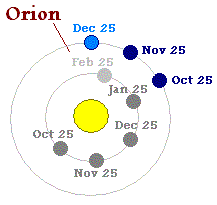
| |
 |
Whether the Earth has halted or reversed in her orbit is difficult to determine. There is strong evidence of Rising Up or Down in the Ecliptic, as many note the sun
too high or low in the sky. Tilts are also easily determined, due to a different arch in the sky painted by the Sun, different rising and setting points for the Sun, and
weather and Cold Patterns. Sweeping arms push the Earth forward, so a reversed orbit is not in pace with the normal forward movement. Thus a reverse orbit is a
stalled orbit, in essence. Where the clocks would place the point where man could look out into the midnight sky too close to dawn for a February 2004 clock on
a globe in a November-December 2003 position, the ever increasing slowing of rotation counters and confuses this. Thus, the constellations would look, if not
precise, at least similar to what man expects from his February skies.
Drop the Earth in her Ecliptic so the northern hemisphere gets more sun and warmth, confusing the trend with Spring. Calculate the Earth more in a December
posture, with a dropped Ecliptic increasing the day length masking the differences between Almanacs and any time published by the Navy. Pull the Earth in toward
the Sun, a Warning and prediction given by both an ancient astronomy chart and a recent crop circle, and as evidenced by the blazing sun and early spring on a
northern hemisphere too long above the sun in a raised ecliptic, and therefore very cold. This also increases the repulsion force issues for both Earth and Venus.
Thus, the weather and length of day would look, if not precise, at least similar to what man expects from a February date.
 Venus, directly in the path where Planet X is moving between the Earth and Sun, is also affected by its approach. And
why would it not, as both Earth and Venus were approaching Planet X on Dec 25 as it rose in front of them, just in from
Orion and finally reaching the inner solar system. Venus is as large as Earth, and more directly in the path of Planet X,
though its size will keep it from a collision as it is large enough to invoke the Repulsion Force. This same Repulsion
Force is retarding Venus in its orbit now. Conjunctions of a crescent Moon and Venus are frequently and popular, the
last on Feb 23, 2004 preceded by one on Dec 25, 2003 and before that, Nov 25, 2003, with slight displacement of the
arrangement between these heavenly bodies. Thus, when viewers saw the conjunction on Feb 23, 2004 approximately
where they anticipated, this was taken to be an affirmation that the Earth’s orbit was normal. But as the photos from Feb
23, 2004 confirm, the lineup was not as anticipated.
Venus, directly in the path where Planet X is moving between the Earth and Sun, is also affected by its approach. And
why would it not, as both Earth and Venus were approaching Planet X on Dec 25 as it rose in front of them, just in from
Orion and finally reaching the inner solar system. Venus is as large as Earth, and more directly in the path of Planet X,
though its size will keep it from a collision as it is large enough to invoke the Repulsion Force. This same Repulsion
Force is retarding Venus in its orbit now. Conjunctions of a crescent Moon and Venus are frequently and popular, the
last on Feb 23, 2004 preceded by one on Dec 25, 2003 and before that, Nov 25, 2003, with slight displacement of the
arrangement between these heavenly bodies. Thus, when viewers saw the conjunction on Feb 23, 2004 approximately
where they anticipated, this was taken to be an affirmation that the Earth’s orbit was normal. But as the photos from Feb
23, 2004 confirm, the lineup was not as anticipated.